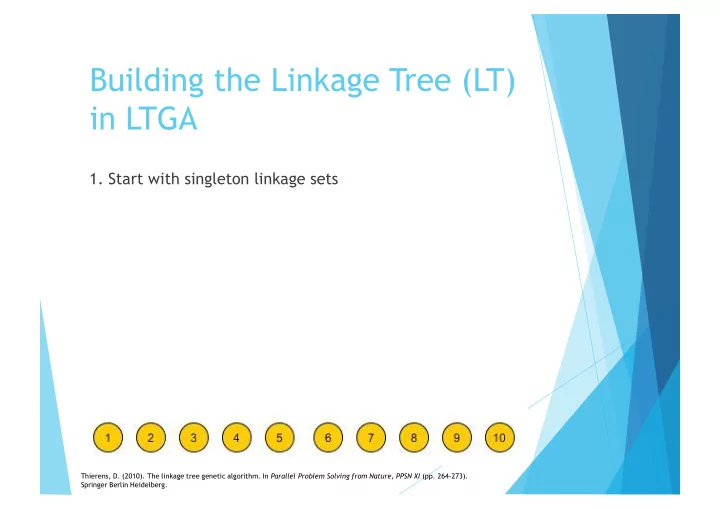

Building the Linkage Tree (LT) in LTGA 1. Start with singleton linkage sets Thierens, D. (2010). The linkage tree genetic algorithm. In Parallel Problem Solving from Nature, PPSN XI (pp. 264-273). Springer Berlin Heidelberg.
Building the Linkage Tree (LT) in LTGA 2. Compute MI for all pairs of clusters 3. Cluster 2 sets with the highest MI 4. Repeat steps 2 and 3 until 2 cluster remain Thierens, D. (2010). The linkage tree genetic algorithm. In Parallel Problem Solving from Nature, PPSN XI (pp. 264-273). Springer Berlin Heidelberg.
Building the Linkage Tree (LT) in LTGA 2. Compute MI for all pairs of clusters 3. Cluster 2 sets with the highest MI 4. Repeat steps 2 and 3 until 2 cluster remain Thierens, D. (2010). The linkage tree genetic algorithm. In Parallel Problem Solving from Nature, PPSN XI (pp. 264-273). Springer Berlin Heidelberg.
Building the Linkage Tree (LT) in LTGA 2. Compute MI for all pairs of clusters 3. Cluster 2 sets with the highest MI 4. Repeat steps 2 and 3 until 2 cluster remain Thierens, D. (2010). The linkage tree genetic algorithm. In Parallel Problem Solving from Nature, PPSN XI (pp. 264-273). Springer Berlin Heidelberg.
Optimal Mixing (OM) in LTGA For each individual p i in the population Traverse all masks in the Linkage Tree p i 3 3 2 2 1 -1 0 0 0 0 Thierens, D., & Bosman, P. A. (2011, July). Optimal mixing evolutionary algorithms. In Proceedings of the 13th annual conference on Genetic and evolutionary computation (pp. 617-624). ACM.
For each mask (in reversed order of merging), randomly select a parent p from the population Donate values of the variables in the mask from the parent to p i If this leads to an improvement, continue the search with the updated solution p i 3 3 2 2 1 -1 0 0 0 0 Initial solution (5 mil) + Random parent p 3 0 1 2 1 -1 0 0 2 0 o i 3 3 2 2 1 -1 0 0 2 0 Improved offspring (4.8 mil) Thierens, D., & Bosman, P. A. (2011, July). Optimal mixing evolutionary algorithms. In Proceedings of the 13th annual conference on Genetic and evolutionary computation (pp. 617-624). ACM.
For each mask (in reversed order of merging), randomly select a parent p from the population Donate values of the variables in the mask from the parent to p i If this leads to an improvement, continue the search with the updated solution o i 3 3 2 2 1 -1 0 0 2 0 Intermediate solution (4.8 mil) + Random parent p 0 0 0 1 1 2 -2 -2 1 1 3 3 2 2 1 2 -2 2 2 0 Infeasible solution Thierens, D., & Bosman, P. A. (2011, July). Optimal mixing evolutionary algorithms. In Proceedings of the 13th annual conference on Genetic and evolutionary computation (pp. 617-624). ACM.
For each mask (in reversed order of merging), randomly select a parent p from the population Donate values of the variables in the mask from the parent to p i If this leads to an improvement, continue the search with the updated solution o i 3 3 2 2 1 -1 0 0 2 0 Intermediate solution (4.8 mil) + Random parent p 3 3 3 1 1 0 0 0 0 0 3 3 3 2 1 -1 0 0 2 0 Worse offspring (6 mil) Thierens, D., & Bosman, P. A. (2011, July). Optimal mixing evolutionary algorithms. In Proceedings of the 13th annual conference on Genetic and evolutionary computation (pp. 617-624). ACM.
For each mask (in reversed order of merging), randomly select a parent p from the population Donate values of the variables in the mask from the parent to p i If this leads to an improvement, continue the search with the updated solution o i 3 3 2 2 1 -1 0 0 2 0 Intermediate solution (4.8 mil) + Random parent p 3 3 1 1 -1 1 2 0 1 0 o i 3 3 1 2 1 -1 0 0 2 0 Improved offspring (4 mil) Thierens, D., & Bosman, P. A. (2011, July). Optimal mixing evolutionary algorithms. In Proceedings of the 13th annual conference on Genetic and evolutionary computation (pp. 617-624). ACM.
Thierens, D. (2010). The linkage tree genetic algorithm. In Parallel Problem Solving from Nature, PPSN XI (pp. 264-273). Springer Berlin Heidelberg.
Recommend
More recommend